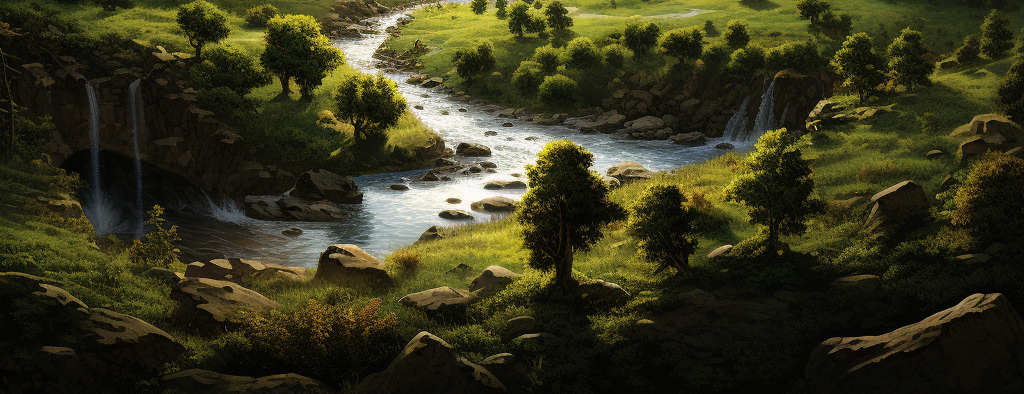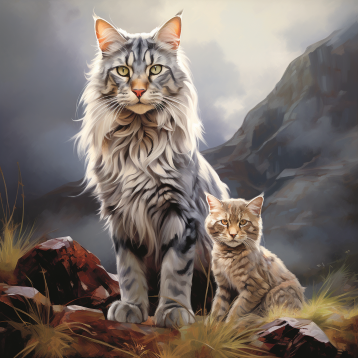Cinderlox (Sin-DER-lox)
The Cinderlox inhabits the solitary volcanic valleys and cinder fields of the once fiery Mount Mour on the island of Mourland. With the choking fumes and regular eruptions of Mount Mour long since ceased, the remote valleys and ashen slopes now harbor small pockets of life, including the rare Cinderlox.
About the size of a bobcat, the Cinderlox exhibits the haunting yowl of a lynx, but possesses the distinctive stub tail or entirely tailless hindquarters of a manx. Its fur varies from tawny brown to silver gray, patterned with brindled stripes that help conceal it amidst the crumbling cinder terrain.
The Cinderlox is ideally suited to the harsh, isolated environment of the Mour valleys. Its padded paws allow silent travel across sharp volcanic rock. Large tufted ears endowed with enhanced hearing can detect the scurries of rodents beneath the cinder banks. And its keen eyes, specially adapted to low light, give it excellent nocturnal hunting skills.
Elusive and seldom seen, the Cinderlox prowls the Mour slopes primarily at sunrise and sunset to hunt. By day, it retires to hidden dens inside old lava tubes and rock crevices. These solitary beasts only converge during breeding season, after which the mothers raise their litters alone.
Though largely a mystery, the Cinderlox remains undisturbed in its remote volcanic home, haunting the ashen valleys unknown to all but a few intrepid explorers. Its adaptation to the unforgiving habitat of Mount Mour remains a marvel of evolutionary isolation.
Basic Information
Genetics and Reproduction
Cinderlox breeding takes place during the brief temperate season on Mourland, when prey is plentiful. The normally solitary Cinderlox will seek out a mate by caterwauling loudly to echo throughout the Mour valleys. Once a pair bonds, they remain together only long enough to mate before parting ways.
After a gestation period of 63-65 days, the female Cinderlox finds a secluded birthing spot, often an old lava tube or deep crevice in the cinder banks. Here she lines a den with gravel and tufts of fur shed from her coat. The Cinderlox typically gives birth to a litter of 2-4 blind, deaf kits.
The mother nurses her kits in the den for the first month of life. During this time, the environment of the den plays a crucial role in the Cinderlox's epigenetic development. The extreme temperature fluctuations between day and night in the cinder habitat trigger unique adaptations that allow the Cinderlox to thrive in this unforgiving ecosystem.
Once weaned, the growing kits will accompany their mother on hunting trips, learning to stalk prey across the treacherous cinder fields. By six months, the young Cinderlox strike out on their own to establish new territories among the valleys of Mour. Their specialized adaptations now primed, these new generations of Cinderlox carry on the survival of this remarkable species.
Dietary Needs and Habits
The Cinderlox relies on stealth and ambush to hunt effectively in its volcanic habitat. Specially adapted for stalking and pouncing, it is a consummate hunter of birds, rodents, and small mammals on the slopes of Mount Mour.
Crouched low amidst the cinder banks and rocky outcroppings, the mottled gray coat of the Cinderlox allows it to blend masterfully into the volcanic landscape. Only the flicking of its stub tail betrays the presence of this patient predator. The Cinderlox will hold still for long periods, large tufted ears swiveling to listen for the faintest scurry or chirp of potential prey.
Once a target is detected, the Cinderlox initiates its stalk, stepping lightly across the crunchy volcanic terrain. Its muted cinder-colored paws tread soundlessly as it creeps toward its quarry. Approaching from downwind to avoid detection, it gets as close as possible before taking action.
When ready to strike, the Cinderlox employs explosive power in its hindquarters to launch itself toward unsuspecting prey in a blur. Employing its sharp retractable claws and vice-like jaws, it seizes small mammals and ground-dwelling birds swiftly. The Cinderlox typically delivers a lethal biting attack to the neck or head to finish off prey.
This combination of camouflage, patience, stealthy footwork, and explosive ambush make the Cinderlox a formidable predator perfectly adapted to the volcanic valleys of Mount Mour. Few creatures that make the cinder slopes their home can evade this master of stalking for long.
Additional Information
Domestication
While the shy, solitary Cinderlox of Mount Mour has never been domesticated, its inherent intelligence and utility could make it an appealing candidate for taming. However, the Cinderlox's wild instincts and elusive nature would pose significant challenges. This unusual feline has evolved as an ambush hunter, not an animal companion.
Any attempt to domesticate the Cinderlox would require isolating cubs from their mother shortly after birth and intensely hand-raising them. Doing so may allow the Cinderlox to psychologically bond with its caretakers. With proper training, its natural abilities like hunting prowess, protective behavior, and keen senses could prove extremely useful for tasks or service roles. The surefooted agility of the Cinderlox could also lend itself well to aiding humans traversing rugged terrain.
However, the Cinderlox's wild temperament and solitary tendencies could be difficult to fully override. There would always be concern of aggression or reversion to territorial displays. The Cinderlox may have increased vigor, but inherit unpredictable traits from its genome. A great deal of caution would be prudent in handling the Cinderlox.
Full domestication would only come after many generations of selective breeding for a calmer demeanor. Taming and training the Cinderlox would be a slow, delicate process with no guarantee of success. The Cinderlox's wild origins may continue to surface at times. Still, properly raised Cinderlox could potentially integrate into human environments while retaining the keen natural abilities of their lineage.





Comments